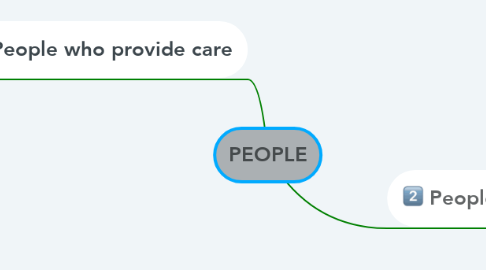
1. People who provide care
1.1. Factors related to staff support and well-being
1.1.1. Meeting core staff needs
1.1.1.1. Psychological Support
1.1.1.1.1. Access to counselling
1.1.1.1.2. Dedicated staff hotline for support
1.1.1.1.3. Monitoring of staff for stress, illness, burn-out
1.1.1.1.4. Mental Health 'First Aid' training for volunteers
1.1.1.2. Financial Support
1.1.1.2.1. Hazard pay
1.1.1.2.2. Compensation/remuneration for overtime
1.1.1.2.3. Life assurance scheme
1.1.1.3. Physical/environmental needs
1.1.1.3.1. Address occupational health concerns
1.1.1.4. Social needs
1.1.1.4.1. Maintaining a work/life balance
1.1.1.4.2. Annual leave backlog / vacation management
1.1.2. Partnership working with staff unions/professional associations
1.2. Factors related to structural gaps in staff skills /competencies
1.2.1. Workplace learning: to make skills-building a key strategic lever for adapting to the new next normal.
1.2.1.1. Resilience training
1.2.1.2. Review training offer: make it digital/accessible
1.2.2. Shift in traditional roles: education and profession re-profiling
1.2.3. Repurpose and upskill for rapid deployment to meet surge capacity needs
1.2.3.1. Consider establishing pathways for accelerated training and early certification of medical, nursing and other key trainee groups.
1.2.3.2. Staffing requirements are relaxed in critical care units to make greater use of multidisciplinary teams re: helping with moving equipment, restocking units, resupplying bed areas and completing administrative tasks.
1.3. Factors related to use of new technologies harnessed by staff
1.3.1. Ensure staff safety whilst working
1.3.2. Enhancing staff scope of work and/or productivity
1.4. Factors related to staff mobilisation and capacity
1.4.1. Mobilisation of professionals/volunteers to meet staff shortages
1.4.1.1. Revalidation and training
1.4.2. Redeployment staff across specialities (flexible, at speed).
1.4.3. 'Bottleneck' monitoring of staff
1.4.3.1. Reducing staff handovers
1.4.3.2. Doing things in parallel rather than step-by-step
2. People who receive care
2.1. Communities
2.1.1. How this crisis has triggered stronger support from the community?
2.1.2. Building trust
2.2. Patients
2.2.1. Delivering person centred care in a crisis
2.2.1.1. How can technology support healthcare professionals to practice person-centred care during a pandemic?
2.2.1.1.1. UK example: using teleconference technologies support dignity in death/end-of-life care
2.2.1.2. Understanding patients’ preferences on new forms of healthcare.
2.2.2. Engagement

